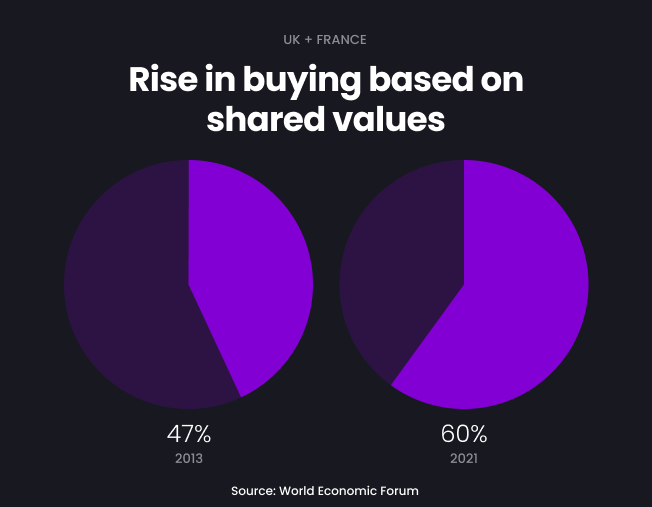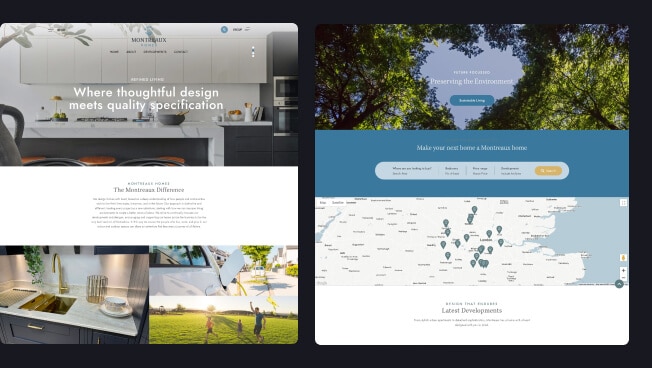
Why a Human-Centric Approach is Crucial for Brands
Table of Contents
TLDR
Shifting to human-centric branding is essential in today’s market, where consumer trust hinges on shared values and transparency. This approach, exemplified by brands like Dove and LEGO, focuses on empathy, co-creation, and transparency to forge deeper customer connections.
However, the transition from traditional methods involves challenges such as internal resistance and the need for deeper customer insights. Overcoming these hurdles through leadership support and cross-functional teamwork is key to building brand loyalty and achieving long-term success.
Introduction: Putting People First
Consumer trust in brands is eroding. Social media and reviews mean brands must focus on people, not just profits. Research shows that shared values and transparency matter more to consumers than quality when choosing brands.

Between 2013 and 2021, the share of respondents in the UK and France who tended to buy based on shared personal and brand principles rose by 17 percentage points to around 60%.
According to research by Adobe, 71% of customers in the UK are likely to stop purchasing from a brand that breaks their trust.
Adopting human-centered practices is key for brands to thrive. This article explores why human-centricity is critical and how to implement it.
• • •
The Changing Brand-Consumer Relationship
Brands can no longer view customers as passive recipients of products and marketing. Consumers want shared values and emotional connections with brands. Authenticity now trumps transactions. Brands must build trust and resonate emotionally through lived values and caring service.
“A brand is no longer what we tell the consumer it is – it’s what consumers tell each other it is.”
Scott Cook, Co-Founder of Intuit
• • •
The Rise of Human-Centered Business Practices
Many brands adopt human-centered practices focused on customer needs. Research like ethnography provides empathy surpassing traditional market research. Human-centered design thinking iteratively brainstorms, prototypes, and tests with users to meet needs. Customer journey mapping reveals pain points and delights. Immersive customer experience centres offer insights missed by surveys alone. Chief Experience Officers ensure the customer perspective guides decisions.
“The most important single thing is to focus obsessively on the customer.”
Jef Bezos, Founder/CEO, Amazon
• • •

Transitioning from Traditional to Human-Centric Branding
Navigating the Challenges
The journey from traditional branding strategies, which often prioritise product features and corporate messaging, to a human-centric approach that places customer needs and values at the heart of every decision is not without its challenges.
The transition involves a paradigm shift in how brands view their relationship with consumers, requiring a deeper understanding of customer experiences, emotions, and values. Here, we delve into the common pitfalls and obstacles brands may encounter in this transition and offer guidance on navigating these challenges successfully.
1. Resistance to Change
Internal resistance to change is one of the most significant barriers to adopting human-centric branding. Traditional branding methods are deeply ingrained in many organisations, and shifting to a new approach can be met with scepticism or reluctance.
How to Overcome:
- Leadership Buy-In: Secure commitment from top management by demonstrating the long-term benefits of human-centered branding, including increased customer loyalty and brand differentiation.
- Educate and Train: Implement training programs that highlight the value of empathy and customer understanding, and the impact of these on the brand’s success.
2. Lack of Customer Insights
A human-centered brand requires a deep understanding of its customers. Traditional methods may not offer the detailed understanding necessary to grasp customers’ emotional motivations and values.
How to Overcome:
- Invest in Research: Utilise qualitative research methods such as interviews, focus groups, and ethnography to gain deeper understanding of customer needs and experiences.
- Leverage Analytics: Use analytics tools to analyse customer behaviour and feedback across touchpoints, identifying patterns and observations that can inform branding strategies.
3. Siloed Organisational Structures
Human-centered branding requires collaboration across the company to boost team performance. Traditional organisational structures with siloed departments can hinder the seamless integration of customer intelligence across the brand experience.
How to Overcome:
- Foster Cross-Functional Teams: Create teams that include members from different departments (e.g., marketing, product development, customer service) to ensure a holistic approach to understanding and addressing customer needs.
- Encourage Open Communication: Implement regular cross-departmental meetings and shared platforms for exchanging knowledge and strategies.
4. Difficulty Measuring Impact
The impact of human-centered branding, particularly in terms of emotional connections and customer loyalty, can be challenging to measure with traditional metrics.
How to Overcome:
- Adopt Relevant Metrics: Integrate customer-centric metrics such as Net Promoter Score (NPS), Customer Satisfaction (CSAT), and Customer Effort Score (CES) to gauge the effectiveness of human-centric strategies.
- Long-term Perspective: Recognise that the benefits of human-centered branding may manifest over a longer term and include qualitative assessments in performance evaluations.
5. Balancing Personalisation with Privacy
To personalise customer experiences, brands risk infringing on customer privacy, a sensitive issue that can erode trust if not handled carefully.
How to Overcome:
- Transparent Data Practices: Clearly communicate how customer information is collected, used, and protected. Offer customers control over their details and adhere to privacy regulations.
- Ethical Data Use: Ensure personalisation efforts are ethical and respect customer boundaries, enhancing experiences without overstepping.
The transition to human-centered branding represents a significant shift in mindset and operations but is crucial for brands seeking to build deeper, more meaningful customer relationships.
By understanding and addressing the challenges inherent in this transition, brands can successfully navigate the path to human-centricity, ensuring their values and practices align with their customers’ evolving expectations. Embracing this approach enhances customer loyalty and brand differentiation and sets a foundation for sustainable growth in the competitive landscape.
• • •
Examples of Human-Centered Business Practices

Dove
Industry: Health & Beauty
Dove’s “Real Beauty” campaign featured diverse women’s bodies, challenging beauty ideals. By banning photoshopping and emphasising diversity and self-esteem, Dove connected worldwide through human truths.
LEGO
Industry: Toys/Entertainment
LEGO has embraced co-creation through its Ideas platform, where fans submit their own designs for new LEGO sets. This approach not only engages the community but also leads to innovative products that reflect the desires and creativity of LEGO’s customer base, exemplifying successful co-creation.

Patagonia
Industry: Outdoor Apparel and Gear
Patagonia’s commitment to environmental sustainability and ethical practices is at the core of its brand identity. The company’s “Worn Wear” program encourages customers to repair, share, and recycle their gear instead of buying new. This initiative strengthens the emotional connection with its customer base and aligns with their shared values of environmental conservation.
Airbnb
Industry: Hospitality/Travel
Airbnb’s “Belong Anywhere” campaign focuses on creating a sense of belonging among its users. By highlighting real stories from hosts and travellers, Airbnb fosters a community-centric platform that values experiences and human connections over transactions, showcasing the power of empathy in branding.
Leading brands now tear down corporate walls, interact with customers directly, and focus on human needs instead of guesswork. Human-centricity allows resonant branding.
• • •

Key Human-Centric Practices
While it’s clear that shared values and transparency matter more to consumers than ever, the question remains: how can brands respond effectively?
Each of the following practices plays a critical role in shaping a brand that survives and thrives by placing humans at the heart of its strategy. It’s about creating a brand people love, trust, and advocate for. By integrating these actionable steps into your business strategy, you can build stronger connections with your customers and foster long-term loyalty.
Empathy
Empathy is the linchpin of customer-centricity. It’s about putting oneself in the customer’s shoes and truly understanding their needs, feelings, and pain points. When brands practice empathy, they go beyond mere transactions; they build relationships. It’s about listening, genuinely caring, and crafting solutions that resonate on a personal level. Empathy turns customers into loyal fans because they feel seen and valued.
Foster a Culture of Empathy
- Conduct Empathy Training: Organise workshops and training sessions for your team to cultivate empathy, helping them understand and share your customers’ feelings.
- Customer Immersion Experiences: Encourage your team to use your products and services from a customer’s perspective to identify pain points and areas for improvement.
Co-Creation
Co-creation is a collaborative effort where brands and customers roll up their sleeves and work together. It’s a democratic approach to product development and service enhancement. By involving customers in the creation process, brands harness a wealth of ideas and foster a deep sense of belonging among their clientele. Co-creation turns customers from passive consumers into active participants, enhancing product relevance and customer satisfaction.
Implement Co-Creation Practices
- Create Feedback Loops: Establish platforms or channels where customers can easily share their ideas, feedback, and suggestions.
- Host Co-Creation Workshops: Invite customers to participate in product development sessions virtually or in-person to brainstorm new ideas or improvements.
Transparency
In today’s digital age, transparency is not just nice to have; it’s essential. It’s about being open about your processes, pricing, and policies. Transparency builds trust, and trust is the foundation of any lasting relationship. When transparent, brands communicate honesty and integrity, reassuring customers they have nothing to hide and can be relied upon.
Enhance Transparency
- Communicate Openly About Challenges: Share your brand’s challenges and the steps you’re taking to overcome them. This builds trust and shows you value customer support and understanding.
- Policy and Process Disclosure: Clearly explain your policies, processes, and pricing to people. Offer detailed FAQs and customer service support to address any queries.
Customer Metrics
Customer metrics are the compass that guides a brand towards true north. By measuring customer satisfaction, net promoter scores, and other relevant metrics, brands can get a clear picture of their performance through the eyes of their customers. This analytics-driven knowledge allows brands to identify areas of excellence and opportunities for improvement, ensuring they remain aligned with customer expectations.
Measure Customer-Centric Metrics
- Implement NPS Surveys: Regularly conduct Net Promoter Score (NPS) surveys to gauge customer loyalty and identify areas for improvement.
- Monitor Customer Satisfaction: Use CSAT surveys and customer feedback to continuously refine and improve your offerings and customer service practices.
Personalisation
Personalisation is the art of making the customer feel like the star of the show. It’s about tailoring experiences, communications, and offerings to meet individual needs and preferences. In a world where people are bombarded with generic messages, personalisation cuts through the noise, making them feel special and understood. It’s a powerful tool for enhancing engagement and loyalty.
Personalise Customer Experiences
- Use Customer Data Wisely: Analyse customer statistics to understand preferences and behaviours, then tailor your communications and offerings accordingly.
- Segmentation and Targeting: Create customer segments based on interests, needs, and behaviours to deliver more relevant and personalised messages.
Customer Advocacy
Customer advocacy goes beyond customer service; it’s about championing the customer’s interests at every touchpoint. Advocacy involves proactively solving problems, exceeding expectations, and delivering value. When customers feel advocated for, they become brand ambassadors, spreading positive word-of-mouth and reinforcing the brand’s reputation.
Champion Customer Advocacy
- Empower Customer Service Teams: Equip your customer service team with the authority and resources to go above and beyond for customers, turning negative experiences into positive ones.
- Create Advocacy Programs: Develop programs that reward consumers for referrals and sharing positive experiences, encouraging organic brand advocacy.
Agility
In an ever-changing marketplace, agility is a brand’s superpower. It’s the ability to pivot quickly in response to market trends, customer feedback, and external challenges. Agile brands stay ahead of the curve, adapting their strategies, products, and services to meet evolving customer needs. Agility ensures relevance and resilience, keeping brands competitive and customer-centric.
Embrace Agility
- Adopt a Flexible Business Model: Stay open to changing your strategies, products, or services based on customer feedback and market trends.
- Rapid Prototyping and Testing: Quickly develop prototypes of new products or features, test them with a segment of your customer base, and iterate based on feedback.
An outside-in, customer-obsessed approach centred on human needs builds loyalty beyond marketing gimmicks. The key is organisation-wide empathy, transparency and advocacy.
• • •

The Benefits of Human-Centricity
Higher Employee Engagement
Human-centered brands often report employee experience benefits, with improved workplace morale and engagement in the work environment, as employees feel more connected to the company’s mission and values.
Increased Customer Retention
By addressing customer pain points with empathy and transparency, brands can forge stronger emotional bonds, leading to higher loyalty and repeat purchases.
Enhanced Productivity
Focusing on human-centric practices can streamline operations and reduce inefficiencies, improving overall productivity.
Market Differentiation
Empathy, co-creation, and advocacy set human-centered brands apart in crowded markets, offering a unique value proposition that attracts consumers.
Premium Pricing Capability
Consumers are willing to pay more for brands they feel emotionally connected to, allowing for premium pricing strategies.
Lifelong Customer Relationships
Prioritising human values over transactions fosters enduring relationships, driving sustained value for the brand.
Brand Relevance and Trust
In today’s market, being human-centric is essential for maintaining relevance, building trust, and fostering growth.
• • •

Real-World Application: Enhancing User Experience in Property Development
Our firsthand experience with a property developer website overhaul exemplifies human-centric branding in action. By prioritising customer experience and insights into brand strategy, we helped Montreaux Homes transition from an online brochure to a platform that resonates with visitors on a much deeper level.
We redefined the site to communicate brand values and a commitment to quality. By integrating intuitive search functionality and delivering comprehensive information on each development, we ensure it not only meets user needs but also fosters a connection between people and properties.
• • •
Wrapping Up
Gone are the days when brands could rely solely on transactional approaches. Today, embracing human-centred methods like empathy and co-creation, which resonate with people’s values, has become crucial for success.
This shift necessitates prioritising human needs over corporate interests, a change that benefits society and strengthens the bond between brands and their communities.
Brands that embody their values are more likely to flourish, building stronger relationships with their customers. Embracing a human-centric approach marks a new era of brand engagement where authenticity and connection reign supreme.





